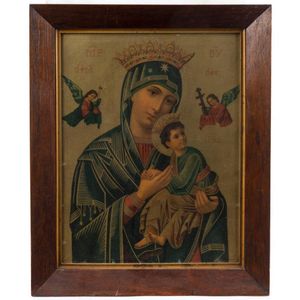Orthodox Christian Mary and Jesus Print in Oak Frame
An Orthodox Christian Mary and Jesus chromolithograph print in a period oak frame, early 20th century, 51 x 41 cm
You must be a subscriber, and be logged in to view price and dealer details.
Subscribe Now to view actual auction price for this item
When you subscribe, you have the option of setting the currency in which to display prices to $Au, $US, $NZ or Stg.
This item has been sold, and the description, image and price are for reference purposes only.
- Oak - Native to Europe and England, oak has been used for joinery, furniture and building since the beginning of the medieval civilisation. It is a pale yellow in colour when freshly cut and darkens with age to a mid brown colour.
Oak as a furniture timber was superceded by walnut in the 17th century, and in the 18th century by mahogany,
Semi-fossilised bog oak is black in colour, and is found in peat bogs where the trees have fallen and been preserved from decay by the bog. It is used for jewellery and small carved trinkets.
Pollard oak is taken from an oak that has been regularly pollarded, that is the upper branches have been removed at the top of the trunk, result that new branches would appear, and over time the top would become ball-like. . When harvested and sawn, the timber displays a continuous surface of knotty circles. The timber was scarce and expensive and was used in more expensive pieces of furniture in the Regency and Victorian periods. - Chromolithograph - A chromolithograph is a type of print that uses multiple layers of color to create a detailed and vibrant image. The process was invented in the mid-19th century and quickly became popular for reproducing a wide variety of images, including advertisements, illustrations, maps, and art prints.
Chromolithography is a complex process that involves creating a separate stone or metal plate for each color in the image. The artist or printmaker first draws the image on a stone or metal plate using a greasy substance, such as a crayon or a wax-based ink. This image is then transferred to a separate plate for each color in the image. The plate is then coated with a thin layer of a light-sensitive substance, and then exposed to a light source. The light hardens the parts of the plate that are not covered by the image, creating a raised surface that will hold the ink.
Once the plates are ready, they are inked up with the corresponding color and printed one at a time, with each color being printed on top of the last. The process is repeated for each color, with the final image being made up of many layers of color.
It was widely used in the late 19th century and early 20th century for posters, postcards, advertising and illustrations in books and magazines. However, chromolithography has been largely replaced by modern printing techniques such as offset printing and digital printing, which are faster, cheaper, and more efficient. Today, chromolithography is mainly used for fine art prints and reproductions, as well as for creating limited-edition prints of historical or cultural significance
This item has been included into following indexes:
- religious objects, Christian
